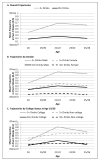High-Intensity Drinking Among Young Adults in the United States: Prevalence, Frequency, and Developmental Change
- PMID: 27488575
- PMCID: PMC5008981
- DOI: 10.1111/acer.13164
High-Intensity Drinking Among Young Adults in the United States: Prevalence, Frequency, and Developmental Change
Abstract
Background: This study is the first to examine the developmental course of high-intensity drinking (i.e., consuming 10+ drinks in a row) across late adolescence and the transition to adulthood.
Methods: National longitudinal data (N = 3,718) from Monitoring the Future were used to examine trajectories of 10+ high-intensity drinking from age 18 through 25/26 overall and across sociodemographic subgroups; results were compared with similar analysis of 5+ binge drinking trajectories.
Results: Results document that 10+ drinkers consume not just a greater quantity of alcohol on a given drinking occasion, but also engage in 5+ drinking more frequently than drinkers who do not report having 10 or more drinks. Developmental patterns for 10+ and 5+ drinking were similar, with peak frequencies reported at age 21/22. Greater peaks in both 10+ and 5+ drinking were documented among men and among college attenders, compared with women and nonattenders, respectively. However, there was a steeper decline in 10+ drinking after age 21/22, indicating that risk for consumption of 10 or more drinks in a row is more clearly focused on the early 20s. Patterns of developmental change in both behaviors were driven largely by college students: No significant age-related change in 10+ drinking was observed among men and women who did not go to college, and no significant age-related change in 5+ drinking was observed among female nonattenders.
Conclusions: Findings underscore the importance of recognizing high-intensity drinkers as a unique high-risk group, and that college attendance is associated with particularly strong peaks in the developmental course of high-intensity drinking.
Keywords: Binge Drinking; College Attendance; Development; Extreme Binge Drinking; High-Intensity; Trajectories.
Copyright © 2016 by the Research Society on Alcoholism.
Figures


Comment in
-
Commentary on Patrick and Colleagues: High-Intensity Drinking Among Young Adults in the United States: Prevalence, Frequency, and Developmental Change.Alcohol Clin Exp Res. 2017 Feb;41(2):270-274. doi: 10.1111/acer.13306. Epub 2017 Jan 19. Alcohol Clin Exp Res. 2017. PMID: 28102543 No abstract available.
Similar articles
-
Drinking Patterns of College- and Non-College-Attending Young Adults: Is High-Intensity Drinking Only a College Phenomenon?Subst Use Misuse. 2018 Nov 10;53(13):2157-2164. doi: 10.1080/10826084.2018.1461224. Epub 2018 Apr 19. Subst Use Misuse. 2018. PMID: 29671683 Free PMC article.
-
Profiles of College Drinkers Defined by Alcohol Behaviors at the Week Level: Replication Across Semesters and Prospective Associations With Hazardous Drinking and Dependence-Related Symptoms.J Stud Alcohol Drugs. 2016 Jan;77(1):38-50. doi: 10.15288/jsad.2016.77.38. J Stud Alcohol Drugs. 2016. PMID: 26751353 Free PMC article.
-
Alcohol-Related Blackouts, Negative Alcohol-Related Consequences, and Motivations for Drinking Reported by Newly Matriculating Transgender College Students.Alcohol Clin Exp Res. 2017 May;41(5):1012-1023. doi: 10.1111/acer.13358. Epub 2017 Mar 21. Alcohol Clin Exp Res. 2017. PMID: 28324915 Free PMC article.
-
Binge drinking and the American college student: what's five drinks?Psychol Addict Behav. 2001 Dec;15(4):287-91. doi: 10.1037//0893-164x.15.4.287. Psychol Addict Behav. 2001. PMID: 11767258 Review.
-
Collateral damage from college drinking: A conceptual framework for alcohol's harms to others among US college students.Subst Use Misuse. 2019;54(8):1297-1308. doi: 10.1080/10826084.2019.1573836. Epub 2019 Apr 22. Subst Use Misuse. 2019. PMID: 31008671 Free PMC article. Review.
Cited by
-
A systematic review of physical activity, sedentary behavior, and substance use in adolescents and emerging adults.Transl Behav Med. 2020 Oct 12;10(5):1155-1167. doi: 10.1093/tbm/ibaa008. Transl Behav Med. 2020. PMID: 33044536 Free PMC article.
-
Drinking Motives and Drinking Consequences across Days: Differences and Similarities between Moderate, Binge, and High-Intensity Drinking.Alcohol Clin Exp Res. 2021 May;45(5):1078-1090. doi: 10.1111/acer.14591. Epub 2021 Apr 2. Alcohol Clin Exp Res. 2021. PMID: 33797768 Free PMC article.
-
High-Intensity Drinking.Alcohol Res. 2018;39(1):49-55. Alcohol Res. 2018. PMID: 30557148 Free PMC article. Review.
-
Shifting Age of Peak Binge Drinking Prevalence: Historical Changes in Normative Trajectories Among Young Adults Aged 18 to 30.Alcohol Clin Exp Res. 2019 Feb;43(2):287-298. doi: 10.1111/acer.13933. Epub 2019 Jan 15. Alcohol Clin Exp Res. 2019. PMID: 30645773 Free PMC article.
-
A mobile-based pregaming drinking prevention intervention for college students: study protocol for a randomized controlled trial.Addict Sci Clin Pract. 2022 Jun 18;17(1):31. doi: 10.1186/s13722-022-00314-5. Addict Sci Clin Pract. 2022. PMID: 35717303 Free PMC article.
References
-
- Alexander EN, Bowen AM. Excessive drinking in college: behavioral outcome, not binge, as a basis for prevention. Addict Behav. 2004;29:1199–205. - PubMed
-
- Bachman JG, Johnston LD, O'Malley PM, Schulenberg JE, Miech RA. The Monitoring the Future project after four decades: Design and procedures (Monitoring the Future Occasional Paper No. 82) Ann Arbor, Mi: Institute for Social Research; 2015. http://monitoringthefuture.org/pubs/occpapers/mtf-occ82.pdf.
-
- Chassin L, Pitts SC, Prost J. Binge drinking trajectories from adolescence to emerging adulthood in a high-risk sample: predictors and substance abuse outcomes. J Consult Clin Psychol. 2002;70:67–78. - PubMed
-
- Chassin L, Presson CC, Sherman SJ. ‘Constructive’ vs. ‘destructive’ deviance in adolescent health behaviors. J Youth Adolesc. 1989;18:245–262. - PubMed
Publication types
MeSH terms
Grants and funding
LinkOut - more resources
Full Text Sources
Other Literature Sources
Medical

